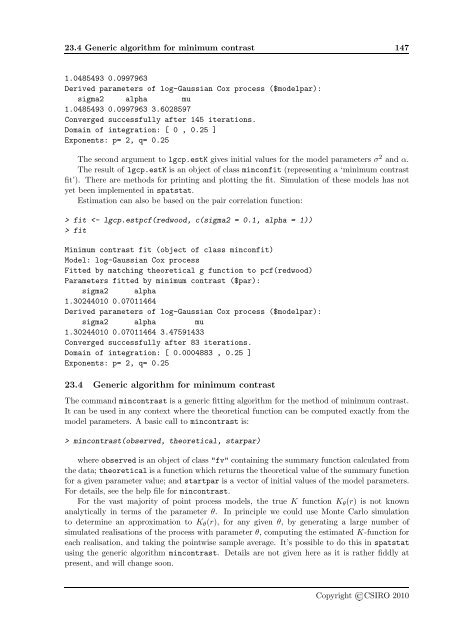Analysing spatial point patterns in R - CSIRO
Analysing spatial point patterns in R - CSIRO
Analysing spatial point patterns in R - CSIRO
Create successful ePaper yourself
Turn your PDF publications into a flip-book with our unique Google optimized e-Paper software.
23.4 Generic algorithm for m<strong>in</strong>imum contrast 147<br />
1.0485493 0.0997963<br />
Derived parameters of log-Gaussian Cox process ($modelpar):<br />
sigma2 alpha mu<br />
1.0485493 0.0997963 3.6028597<br />
Converged successfully after 145 iterations.<br />
Doma<strong>in</strong> of <strong>in</strong>tegration: [ 0 , 0.25 ]<br />
Exponents: p= 2, q= 0.25<br />
The second argument to lgcp.estK gives <strong>in</strong>itial values for the model parameters σ 2 and α.<br />
The result of lgcp.estK is an object of class m<strong>in</strong>confit (represent<strong>in</strong>g a ‘m<strong>in</strong>imum contrast<br />
fit’). There are methods for pr<strong>in</strong>t<strong>in</strong>g and plott<strong>in</strong>g the fit. Simulation of these models has not<br />
yet been implemented <strong>in</strong> spatstat.<br />
Estimation can also be based on the pair correlation function:<br />
> fit fit<br />
M<strong>in</strong>imum contrast fit (object of class m<strong>in</strong>confit)<br />
Model: log-Gaussian Cox process<br />
Fitted by match<strong>in</strong>g theoretical g function to pcf(redwood)<br />
Parameters fitted by m<strong>in</strong>imum contrast ($par):<br />
sigma2 alpha<br />
1.30244010 0.07011464<br />
Derived parameters of log-Gaussian Cox process ($modelpar):<br />
sigma2 alpha mu<br />
1.30244010 0.07011464 3.47591433<br />
Converged successfully after 83 iterations.<br />
Doma<strong>in</strong> of <strong>in</strong>tegration: [ 0.0004883 , 0.25 ]<br />
Exponents: p= 2, q= 0.25<br />
23.4 Generic algorithm for m<strong>in</strong>imum contrast<br />
The command m<strong>in</strong>contrast is a generic fitt<strong>in</strong>g algorithm for the method of m<strong>in</strong>imum contrast.<br />
It can be used <strong>in</strong> any context where the theoretical function can be computed exactly from the<br />
model parameters. A basic call to m<strong>in</strong>contrast is:<br />
> m<strong>in</strong>contrast(observed, theoretical, starpar)<br />
where observed is an object of class "fv" conta<strong>in</strong><strong>in</strong>g the summary function calculated from<br />
the data; theoretical is a function which returns the theoretical value of the summary function<br />
for a given parameter value; and startpar is a vector of <strong>in</strong>itial values of the model parameters.<br />
For details, see the help file for m<strong>in</strong>contrast.<br />
For the vast majority of <strong>po<strong>in</strong>t</strong> process models, the true K function K θ (r) is not known<br />
analytically <strong>in</strong> terms of the parameter θ. In pr<strong>in</strong>ciple we could use Monte Carlo simulation<br />
to determ<strong>in</strong>e an approximation to K θ (r), for any given θ, by generat<strong>in</strong>g a large number of<br />
simulated realisations of the process with parameter θ, comput<strong>in</strong>g the estimated K-function for<br />
each realisation, and tak<strong>in</strong>g the <strong>po<strong>in</strong>t</strong>wise sample average. It’s possible to do this <strong>in</strong> spatstat<br />
us<strong>in</strong>g the generic algorithm m<strong>in</strong>contrast. Details are not given here as it is rather fiddly at<br />
present, and will change soon.<br />
Copyright<strong>CSIRO</strong> 2010












